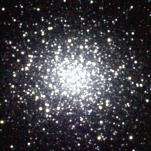Messier 14
Messier 14 (also known as M14 or NGC 6402) is a globular cluster of stars in the constellation Ophiuchus. It was discovered by Charles Messier in 1764.
| Messier 14 | |
|---|---|
 Messier 14, from 2MASS | |
| Observation data (J2000 epoch) | |
| Class | VIII[1] |
| Constellation | Ophiuchus |
| Right ascension | 17h 37m 36.15s[2] |
| Declination | –03° 14′ 45.3″[2] |
| Distance | 30.3 kly (9.3 kpc)[3] |
| Apparent magnitude (V) | +8.32[2] |
| Apparent dimensions (V) | 11.0′ |
| Physical characteristics | |
| Mass | 1.04×106[3] M☉ |
| Radius | 50 ly[4] |
| Metallicity | = –1.28[3] dex |
| Other designations | NGC 6402[2] |
At a distance of about 30,000 light-years, M14 contains several hundred thousand stars. At an apparent magnitude of +7.6 it can be easily observed with binoculars. Medium-sized telescopes will show some hint of the individual stars of which the brightest is of magnitude +14.
The total luminosity of M14 is in the order of 400,000 times that of the Sun corresponding to an absolute magnitude of -9.12. The shape of the cluster is decidedly elongated. M14 is about 100 light-years across.[5]
A total of 70 variable stars are known in M14, many of the W Virginis variety common in globular clusters. In 1938, a nova appeared, although this was not discovered until photographic plates from that time were studied in 1964. It is estimated that the nova reached a maximum brightness of magnitude +9.2, over five times brighter than the brightest 'normal' star in the cluster.
Slightly over 3° southwest of M14 lies the faint globular cluster NGC 6366.
Gallery
 Messier 14 with amateur telescope
Messier 14 with amateur telescope Map showing location of Messier 14
Map showing location of Messier 14
References
- Shapley, Harlow; Sawyer, Helen B. (August 1927), "A Classification of Globular Clusters", Harvard College Observatory Bulletin, 849 (849): 11–14, Bibcode:1927BHarO.849...11S.
- "NGC 6402". SIMBAD. Centre de données astronomiques de Strasbourg. Retrieved 2006-11-15.
- Boyles, J.; et al. (November 2011), "Young Radio Pulsars in Galactic Globular Clusters", The Astrophysical Journal, 742 (1): 51, arXiv:1108.4402, Bibcode:2011ApJ...742...51B, doi:10.1088/0004-637X/742/1/51.
- distance × sin( diameter_angle / 2 ) = 50 ly radius
- "Messier 14 | Messier Objects". Retrieved 2020-04-14.
External links
| Wikimedia Commons has media related to Messier 14. |
- SEDS Messier pages on M14
- M14, Galactic Globular Clusters Database page
- NASA Astronomy Picture of the Day: The Comet and the Star Cluster (11 April 2016) - one of the two being M14
- Messier 14 on WikiSky: DSS2, SDSS, GALEX, IRAS, Hydrogen α, X-Ray, Astrophoto, Sky Map, Articles and images
